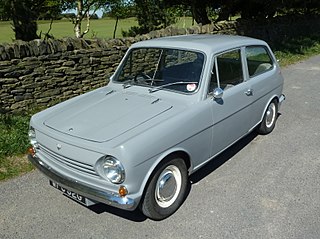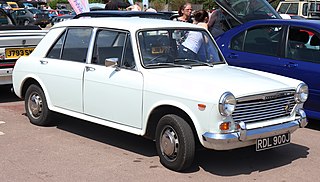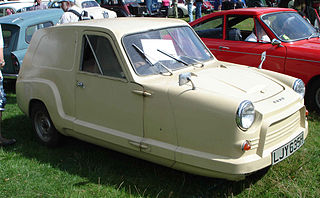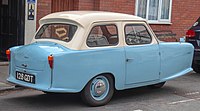
The Mini is a small, two-door, four-seat car, developed as ADO15, and produced by the British Motor Corporation (BMC) and its successors, from 1959 until 2000. Minus a brief hiatus, original Minis were built for four decades and sold during five, from the last year of the 1950s into the last year of the 20th century, over a single generation, as fastbacks, estates, and convertibles.

Reliant Motor Company was a British car manufacturer based in Tamworth, Staffordshire, England. It was founded in 1935 and ended car production in 2002, the company had been known as "Reliant Motor Company" until the 1990s when it became "Reliant Motors" and then finally became "Reliant Cars LTD" after production had ended of the Robin as the company was restructured to be a car import business. It is now a dormant company and the only entity left is a separate parts company created called "Reliant Partsworld" which produces parts for Reliant vehicles.

The Reliant Fox is a small four-wheeled glass-fibre utility vehicle manufactured between 1983 and 1990 by the Reliant Motor Company in Tamworth, England. It used Reliant's own 848cc aluminium inline four-cylinder engine and a galvanised chassis based on that of the Reliant Kitten.

The Vauxhall Chevette is a supermini car that was manufactured by Vauxhall in the United Kingdom from 1975 to 1984. It was Vauxhall's version of the "T-Car" small-car family from Vauxhall's parent General Motors (GM), and based primarily on the Opel Kadett C. The family also included the Isuzu Gemini in Japan, the Holden Gemini in Australia, the Chevrolet Chevette in the United States, Canada, Brazil, Colombia, Ecuador and Argentina, and in the U.S. and Canada it was also rebadged as the Pontiac Acadian/Pontiac T1000.

The Reliant Rebel is a small four-wheeled car that was produced by Reliant between 1964 and 1974. It was designed by Reliant to be a market test to push Reliant into other parts of the market instead of just 3-wheelers.

The Ford Zephyr is an executive car manufactured by Ford of Britain from 1950 until 1972. The Zephyr and its luxury variants, the Ford Zodiac and Ford Executive, were the largest passenger cars in the British Ford range from 1950 until their replacement by the Consul and Granada models in 1972.

The Triumph Spitfire is a British sports car manufactured over five production iterations between 1962 and 1980. Styled for Standard-Triumph in 1957 by Italian designer Giovanni Michelotti, the Spitfire was introduced at the London Motor Show in 1962. It was manufactured at the Standard-Triumph Canley works, with approximately 315,000 produced over 18 years.
Sharps Commercials Ltd was a British car maker based in Preston, Lancashire. It was founded in 1922 by Paul Sharp. It changed its name to Bond Cars Ltd in 1963. The company was taken over by the Reliant Motor Co Ltd of Tamworth, Staffordshire in February 1969, who eventually closed the Preston factory at the end of July 1970, transferring the spare parts business for the Bond Minicar, 875 saloon, 875 Ranger van and Equipe models to a firm called Bob Joyner & Son in Oldbury in the English Midlands. Reliant nevertheless continued to use the Bond name until 1974 on Bond Bug models made at their own Tamworth plant.

The Reliant Robin is a small three-wheeled car produced by the Reliant Motor Company in Tamworth, England. It was offered in several versions over a period of 30 years. It is the second-most popular fibreglass car in history after the Chevrolet Corvette, with Reliant being the second-biggest British car manufacturer for a time.

The Triumph Vitesse is a compact six-cylinder car built by Standard-Triumph from 1962 to 1971. The car was styled by Giovanni Michelotti, and was available in saloon and convertible variants.

The BMC ADO16 is a range of small family cars built by the British Motor Corporation (BMC) and, later, British Leyland. Launched in 1962, it was Britain's best-selling car from 1963 to 1966 and from 1968 to 1971. The ADO16 was marketed under various make and model names; however, the Austin 1100 and Morris 1100 were the most prolific of all the ADO16 variants. The car's ubiquity at the height of its popularity led to it simply being known as the 1100 (eleven-hundred) in its home market. Also made with a 1300cc engine, it was then typically called 1300.

The BMC B series was a line of straight-4 & straight-6 internal combustion engine mostly used in motor cars, created by British automotive manufacturer Austin Motor Company.

The Reliant Rialto is a three-wheeled car that was manufactured by Reliant Motor Company, replacing the original Mk 1 Reliant Robin in 1982. It featured a much squarer aerodynamic body, servicing panels, a single large windscreen wiper, a thicker fibreglass body, and altered interior, but the chassis, engine, and a lot of large components were carried over from the previous model. The improvements gave the Rialto improved high-speed stability as well as improved fuel economy.

Elva was a sports and racing car manufacturing company based in Bexhill, then Hastings and Rye, East Sussex, United Kingdom. The company was founded in 1955 by Frank G. Nichols. The name comes from the French phrase elle va.

The Ford Escort is a small family car that was manufactured by Ford of Europe from 1968 until 2000. In total there were six generations, spread across three basic platforms: the original, rear-wheel-drive Mk.1/Mk.2 (1968–1980), the "Erika" front-wheel-drive Mk.3/Mk.4 (1980–1992), and the final CE-14 Mk.5/Mk.6 (1990–2002) version. Its successor, the Ford Focus, was released in 1998, but the final generation of Escort was phased out gradually, with the panel van version ending production in 2002 in favour of the Ford Transit Connect.

Bond Minicar is a series of economical three-wheeled microcars which were manufactured by the British car manufacturer Sharp's Commercials Ltd, in Preston, Lancashire, between 1949 and 1966.

The Bond 875 is a small three-wheeled car partly designed by Lawrence "Lawrie" Bond and manufactured by Bond Cars Ltd in Preston, United Kingdom, from 1965 to 1970. There was also a van version from 1967, known as the Ranger.

The Bond Equipe is an English 2+2 sports car, manufactured by Bond Cars Ltd from 1963 to 1970. It was the first 4-wheeled vehicle from Bond Cars.

The Ford P100 is a car-based pickup truck that was built by Ford from 1971 to 1995, initially in South Africa, and later Portugal. It was based on medium-sized Ford passenger cars, originally the Cortina/Taunus and from 1988 the Ford Sierra. Initially marketed as the Ford Cortina Pickup, the P100 name was adopted in 1982. The P-100 name had previously been used on a small North American panel van in the 1960s.

The Bond Bug is a small British two-seat, three-wheeled automobile which was designed by Tom Karen of Ogle Design for Reliant Motor Company, who built it from 1970 to 1974, initially at Bond Cars Ltd factory, but subsequently at Reliant's Tamworth factory. It is a wedge-shaped microcar, with a lift-up canopy and side screens instead of conventional doors.






























